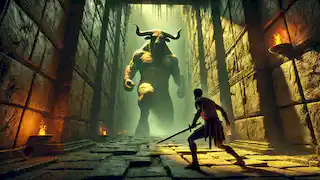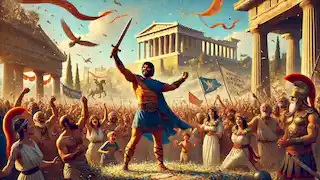In the heart of ancient Greece, a land of gods and legends, there was a story that haunted the imagination of all who heard it—a tale filled with darkness, betrayal, heroism, and a monster lurking deep within a labyrinth. This is the story of the Minotaur, a creature born from the hubris of a king, the vengeance of a god, and the unholy union of man and beast. The story unfolds in the kingdom of Crete, where a proud king defied the will of the gods, setting into motion a chain of events that would lead to the creation of one of the most fearsome creatures of myth. But it is also the story of a hero, a brave prince who risked everything to bring an end to the terror that plagued his people.
The tale begins with the choices of men, the will of the gods, and the power of fate. From the shores of Crete to the halls of Athens, and deep within the twisting passages of the labyrinth, this is the story of the Minotaur. The story of the Minotaur begins with King Minos, ruler of Crete, a man whose ambition knew no bounds. He was not content merely to rule his kingdom; he sought the favor of the gods, believing that divine approval would cement his power and ensure his legacy. His opportunity came when Poseidon, god of the sea, granted him a magnificent white bull. This was no ordinary bull—it was a creature of such beauty and strength that it seemed almost divine. The bull was meant to be a sacrifice to the gods, a symbol of Minos' devotion and obedience. But as Minos gazed upon the bull, his heart was filled with greed. He could not bear to part with such a magnificent creature. And so, in a moment of arrogance, he decided to deceive the gods. He sacrificed a lesser bull in place of the one given to him by Poseidon, thinking that no one would be the wiser. But the gods are not so easily deceived, and Poseidon, enraged by Minos' betrayal, sought revenge. It was Minos’ wife, Queen Pasiphaë, who would bear the brunt of the god's wrath. Poseidon cast a terrible curse upon her, twisting her desires and filling her with an unnatural lust for the very bull her husband had refused to sacrifice. Consumed by this dark desire, Pasiphaë sought out the help of Daedalus, a brilliant inventor and craftsman who had come to Crete seeking refuge from the political intrigue of Athens. Pasiphaë begged Daedalus to create a wooden cow in which she could hide, allowing her to fulfill her monstrous desires without detection. Reluctantly, Daedalus agreed. He crafted a hollow wooden cow, covered in real hides, so lifelike that it fooled even the bull. Hidden inside, Pasiphaë lured the beast to her, and their unnatural union resulted in the birth of a creature that was neither fully human nor fully animal—the Minotaur. The Minotaur was a monster with the body of a man and the head of a bull, a creature of immense strength and terrifying ferocity. From the moment of its birth, it was clear that this was no ordinary child. Its hunger was insatiable, its strength unmatched, and its temper uncontrollable. It quickly became apparent that the creature could not live among men. It was too dangerous, too unpredictable, and its very existence was a constant reminder of the gods' anger. King Minos, ashamed of what had become of his wife and horrified by the creature that now bore his name, turned once again to Daedalus. This time, he asked the inventor to create a prison for the Minotaur—something that would contain the beast and keep it from harming the people of Crete. Daedalus rose to the challenge, designing a labyrinth so complex and so intricate that even he, its creator, could scarcely navigate its twisting passages. The labyrinth was built deep beneath the palace of Knossos, its entrance hidden from all but the most trusted of Minos' guards. The labyrinth was more than just a prison; it was a maze designed to confound and confuse, with dead ends, false paths, and winding corridors that seemed to go on forever. It was a place where no one, not even the most skilled tracker, could hope to find their way out once they had entered. This was the Minotaur's home—a dark, endless prison where it could wander for eternity, cut off from the world of men. For years, the Minotaur roamed the labyrinth, its hunger growing with each passing day. King Minos, fearing the creature’s wrath, began to send it offerings of flesh—criminals, slaves, and, eventually, even the sons and daughters of his own people. The beast devoured them all, and still, its hunger was not sated. But the curse of the Minotaur did not remain confined to Crete. In time, it would spread beyond the island's shores, reaching even the great city of Athens. This new chapter of the Minotaur's story would begin with a war—a conflict between Crete and Athens that would seal the fates of both cities. The war between Crete and Athens was a brutal and bloody conflict, one that ended in Crete's favor. As part of the peace settlement, King Minos demanded a tribute from Athens—a terrible price that would ensure Crete’s dominance over its rival city. Every nine years, Athens was required to send seven of its finest young men and seven of its fairest maidens to Crete. These young people were not sent as ambassadors or envoys; they were sacrifices, offerings to the Minotaur that dwelled within the labyrinth. The Athenians were horrified by this arrangement, but they had little choice. The alternative was renewed war with Crete, a conflict they knew they could not win. And so, every nine years, the people of Athens gathered their sons and daughters and sent them across the sea to their doom. It was on the eve of the third tribute that the story of Theseus began. Theseus was the son of King Aegeus of Athens, a young prince known for his bravery and his skill in battle. He was a hero in the making, a man destined for greatness. When he learned of the tribute to Crete, he was outraged. He could not bear the thought of his people living in fear, their finest youths being sent to their deaths. And so, Theseus made a bold decision: he would be one of the fourteen sent to Crete, but he would not go as a victim. He would go as a hero, determined to slay the Minotaur and free Athens from the terrible tribute. Theseus’ decision was met with both fear and admiration. His father, King Aegeus, was heartbroken at the thought of losing his son, but he knew that Theseus would not be swayed. Before Theseus left for Crete, Aegeus made him promise one thing: if he succeeded in his quest, he was to raise white sails on his ship as he returned to Athens, a signal to his father that he was alive and victorious. If he failed, the sails would remain black, a sign of his death. With this promise made, Theseus set sail for Crete, accompanied by the other young men and women chosen for the tribute. The journey was long and perilous, but Theseus’ determination never wavered. He knew that the fate of his city rested on his shoulders, and he was ready to face whatever dangers lay ahead. When they arrived in Crete, the Athenians were brought before King Minos, who looked upon them with cold indifference. To him, they were nothing more than sacrifices, their lives forfeit to the beast that roamed the labyrinth beneath his palace. But there was one person in the court who took a special interest in Theseus—Ariadne, the daughter of King Minos. Ariadne was a woman of great beauty and intelligence, but she was also a woman trapped in a world of politics and power, where her wishes were rarely considered. From the moment she saw Theseus, she was captivated by his bravery and his determination. She knew that he was different from the other sacrifices, that he was not content to simply accept his fate. And so, she made a decision that would change both their lives forever. Ariadne approached Theseus in secret, offering him her help in defeating the Minotaur. She had grown weary of the bloodshed, tired of seeing innocent lives lost to the beast that her father kept hidden beneath the palace. She could not bear the thought of Theseus meeting the same fate as those who had come before him. She gave him a ball of thread and explained how it could be used to navigate the labyrinth. By tying one end of the thread to the entrance of the maze, Theseus would be able to trace his path back to safety after he had slain the Minotaur. Ariadne also warned him of the Minotaur's great strength and ferocity, but she believed in Theseus’ ability to defeat the creature. In exchange for her help, she asked that Theseus take her with him when he left Crete, to spare her from a life under her father’s oppressive rule. Theseus agreed, and with Ariadne’s aid, he prepared himself for the ordeal that lay ahead. That night, as the other tributes slept, Theseus crept out of his quarters and made his way to the entrance of the labyrinth. The door was opened, and Theseus stepped inside, the ball of thread in hand. He tied the end of the thread to the entrance and began his descent into the darkness. The labyrinth was a place of shadows and silence, its corridors twisting and turning in ways that defied logic and reason. The walls were high and imposing, their cold stone surfaces offering no comfort or solace to those who ventured within. As Theseus made his way deeper into the maze, he could feel the weight of the darkness pressing down on him, the air growing thick with the stench of blood and decay. But Theseus was not afraid. He was a hero, born to face dangers that would break lesser men. He moved through the labyrinth with purpose, his mind focused on the task at hand. The ball of thread unraveled behind him, marking his path, but it was the sound of the Minotaur’s heavy breathing that guided him forward. The beast was near, its presence a tangible force in the air. At last, Theseus came face to face with the Minotaur. The creature was even more terrifying than he had imagined—its massive body covered in coarse, matted fur, its eyes burning with a savage intelligence. The Minotaur let out a bellowing roar that echoed through the labyrinth, shaking the very walls of its prison. The battle that followed was fierce and brutal. The Minotaur charged at Theseus, its powerful hooves pounding the stone floor, its horns aimed directly at the young hero. But Theseus was quick, his reflexes honed by years of training. He dodged the beast’s attack and struck out with his sword, the blade slicing through the Minotaur’s thick hide. Again and again, Theseus and the Minotaur clashed, the sound of their battle reverberating through the labyrinth. The creature was strong, but Theseus was clever. He used the narrow corridors of the maze to his advantage, dodging and weaving, striking at the beast whenever he saw an opening. The Minotaur, enraged and confused by the unfamiliar terrain, became reckless in its attacks, leaving itself vulnerable to Theseus' blade. Finally, Theseus found his opportunity. The Minotaur, exhausted and bleeding from numerous wounds, lunged at him one last time. But this time, Theseus was ready. He sidestepped the creature’s charge and drove his sword deep into the Minotaur’s chest. The beast let out a final, agonized roar before collapsing to the ground, its life ebbing away. Theseus stood over the fallen creature, his breath coming in ragged gasps. The battle was over. The Minotaur was dead. He had done what no other man had dared to do—he had entered the labyrinth and emerged victorious. With the beast slain, Theseus retraced his steps through the labyrinth, following the thread back to the entrance. When he emerged from the maze, he was greeted by the other tributes, their faces filled with awe and disbelief. Theseus had done the impossible—he had slain the Minotaur and freed them from their terrible fate. The people of Crete were stunned by Theseus' victory, but none more so than King Minos himself. For years, the Minotaur had been both a curse and a source of power for Minos, a symbol of his control over both his people and the city of Athens. But now, that power was gone, and Minos was left to grapple with the consequences of his actions. Despite his victory, Theseus had no desire to stay in Crete. He had made a promise to Ariadne, and he intended to keep it. Together with the other tributes, he set sail for Athens, Ariadne by his side. Their journey home was filled with celebration and relief, the shadow of the Minotaur no longer hanging over them. But their joy was short-lived. Along the way, they stopped at the island of Naxos to rest. It was here that fate intervened once again. According to some versions of the story, Theseus abandoned Ariadne on the island, leaving her heartbroken and alone. Others say that it was the gods themselves who commanded Theseus to leave her behind, for she was destined to marry the god Dionysus, who would soon arrive to claim her as his bride. Whatever the truth, Theseus continued his journey home without Ariadne. But in his excitement and haste, he forgot to change the sails on his ship from black to white, as he had promised his father. As the ship approached the shores of Athens, King Aegeus stood on the cliffs, scanning the horizon for any sign of his son. When he saw the black sails, his heart sank. Believing that Theseus had perished in the labyrinth, Aegeus was overcome with grief and despair. In his sorrow, he threw himself into the sea, which would forever bear his name—the Aegean Sea. When Theseus finally arrived in Athens, he was hailed as a hero. But the celebration was tinged with sadness, for his victory had come at a great cost. His father was dead, and the city mourned its fallen king. Theseus was left to grapple with the weight of his own actions, the knowledge that his triumph had been marred by tragedy. The tale of Theseus and the Minotaur became one of the most enduring myths of ancient Greece, a story that captured the imagination of generations. It was a tale of bravery and sacrifice, of love and betrayal, of the thin line between heroism and tragedy. Theseus went on to become one of the greatest kings in Athenian history, his rule marked by wisdom and justice. But the shadow of the Minotaur never truly left him. Though he had slain the beast, the memories of that dark labyrinth, of the lives lost, and of the father he had unwittingly caused to die, remained with him always. As for the labyrinth, it fell into ruin in the years that followed, its twisting passages lost to time and memory. But the story of the Minotaur lived on, passed down through the ages as a cautionary tale—a reminder of the dangers of hubris, the power of the gods, and the courage it takes to face the monsters that dwell in the darkness. And so, the tale of the Minotaur, the cursed creature born of divine wrath and human folly, endures to this day. It is a story of heroes and monsters, of choices and consequences, and of the enduring power of myth.The Pride of King Minos

The Labyrinth and the Curse
The Athenian Tribute

The Love of Ariadne
The Labyrinth and the Beast

The Return to Athens

Epilogue: The Legacy of Theseus and the Minotaur




















